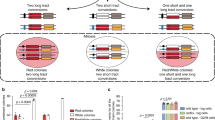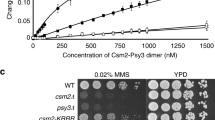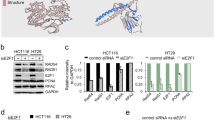Abstract
The HR6A and HR6B genes, homologs of the yeast RAD6 gene, encode ubiquitin conjugating enzymes that are required for postreplication repair (PRR) of DNA and damage-induced mutagenesis. We show here that consistent with its role as a PRR protein, HR6 protein (referred as RAD6) expression is cell cycle regulated, with maximal levels expressed in late S/G2 phases of the cell cycle. Exposure of MCF10A cells to adriamycin (ADR) causes enhancement in the levels of RAD6B mRNA and protein. Inclusion of actinomycin D abolishes both basal and ADR-induced RAD6B transcription indicating that ADR-induced effects on RAD6B transcription result from an increase in transcriptional activity rather than from regulation of RAD6B mRNA stability. The increase in RAD6 protein expression observed in ADR-treated cells is dependent upon transcription and de novo protein synthesis, as addition of actinomycin D and cycloheximide eliminated the induction effects. Using in vivo crosslinking experiments, we demonstrate that only a small proportion of RAD6 is associated with chromatin in untreated MCF10A cells. However, treatment with ADR or cisplatin is accompanied by a significant increase and redistribution of RAD6 to DNA, and RAD6, RAD18, PCNA, phosphohistone H3, as well as p53 proteins are all found in the DNA fractions. These findings suggest that although RAD6 protein is present in the nucleus, its recruitment to the chromatin appears to be modulated by DNA damage. Whereas MCF10A cells engineered to overexpress ectopic RAD6B are significantly more resistant to ADR and cisplatin as compared to empty vector-transfected cells, MCF10A cells stably transfected with antisense RAD6B display hypersensitivity to these damage-inducing drugs. Analysis of PRR capacities in cisplatin-treated MCF10A cells stably transfected with empty vector, RAD6B or antisense RAD6B showed that whereas RAD6B-overexpressing and vector control MCF10A cells possessed the ability to convert newly synthesized DNA to higher molecular weight species, MCF10A cells depleted of RAD6B are PRR-compromised. Although no human diseases have been linked to mutations in the PRR pathway genes, these data suggest that RAD6 may play an essential role in DNA damage tolerance and recovery via modulation of PRR, and that imbalances in the levels of RAD6 could lead to changes in drug sensitivity and damage-induced mutagenesis.
This is a preview of subscription content, access via your institution
Access options
Subscribe to this journal
Receive 50 print issues and online access
$259.00 per year
only $5.18 per issue
Buy this article
- Purchase on Springer Link
- Instant access to full article PDF
Prices may be subject to local taxes which are calculated during checkout







Similar content being viewed by others
References
Bailly V, Lauder S, Prakash S and Prakash L . (1997). J. Biol. Chem., 272, 23360–23365.
Broomfield S, Chow BL and Xiao W . (1998). Proc. Natl. Acad. Sci. USA, 95, 5678–5683.
Broomfield S, Hryciw T and Xiao W . (2001). Mutat. Res., 486, 167–184, (review).
Cejka P, Vondrejs V and Storchova Z . (2001). Genetics, 159, 953–963.
Ellison KS, Gwozd T, Prendergast JA, Paterson MC and Ellison MJ . (1991). J. Biol. Chem., 266, 24116–24120.
Friedberg EC, Walker GC and Siede W . (1995). DNA Repair and Mutagenesis. ASM Press: Washington, DC.
Haynes RH and Kunz BA . (1981). The Molecular Biology of the Yeast Saccharomyces cerevisiae: Life Cycle and Inheritance, Strathern J, Jones E and Broach J (eds). Cold Spring Harbor Laboratory: Cold Spring Harbor, pp. 371–414.
Hoege C, Pfander B, Moldovan GL, Pyrowolakis G and Jentsch S . (2002). Nature, 419, 135–141.
Jentsch S, McGrath JP and Varshavsky A . (1987). Nature, 329, 131–134.
Kim H, You S, Farris J, Foster LK and Foster DN . (2001). Oncogene, 20, 3306–3310.
Koken MH, Hoogerbrugge JW, Jasper-Dekker I, de Wit J, Willemsen R, Roest HP, Grootegoed JA and Hoeijmakers JH . (1996). Dev. Biol., 173, 119–132.
Koken MH, Reynolds P, Jaspers-Dekker I, Prakash L, Prakash S, Bootsma D and Hoeijmakers JHJ . (1991). Proc. Natl. Acad. Sci. USA, 88, 8865–8869.
Koken MH, Smit EM, Jaspers-Dekkers I, Oostra BA, Hagemeijer D, Bootsma D and Hoeijmakers JH . (1992). Genomics, 12, 447–453.
Kupiec M and Simchen G . (1984). Curr. Genet., 8, 559–566.
Lawrence CW . (1982). Adv. Genet., 21, 173–254.
Lawrence C . (1994). BioEssays, 16, 253–258.
Lehman AR . (1972). J. Mol. Biol., 66, 319–337.
Lehman AR, Kirk-Bell S, Arlett CF, Paterson MC, Lohman PH, de Weerd-Kastelein EA and Bootsma D . (1975). Proc. Natl. Acad. Sci. USA, 72, 219–223.
Lyakhovich A and Shekhar MP . (2003). Mol. Cell. Biol., 23, 2463–2475.
McDonald JP, Levine AS and Woodgate R . (1997). Genetics, 147, 1557–1568.
Prakash S, Sung P and Prakash L . (1990). The Eukaryotic Nucleus. Vol. 1. Straus PR, Wilson SH (eds). Telford Press: Caldwell, NJ, pp. 275–292.
Reynolds P, Weber S and Prakash L . (1985). Proc. Natl. Acad. Sci. USA, 82, 168–172.
Roche H, Gietz RD and Kunz BA . (1995). Genetics, 140, 443–456.
Roest HP, van Klaveren J, de Wit J, van Gurp CG, Koken MH, Vermey M, van Roijen JH, Hoogerbrugge JW, Vreeburg JT, Baarends WM, Bootsma D, Grootegoed JA and Hoeijmakers JH . (1996). Cell, 86, 799–810.
Shekhar MP, Lyakhovich A, Heng H, Visscher DW and Kondrat N . (2002). Cancer Res., 62, 2115–2124.
Shieh SY, Ikeda M, Taya Y and Prives C . (1997). Cell, 91, 325–334.
Solomon MJ and Varshavsky A . (1985). Proc. Natl. Acad. Sci. USA, 82, 6470–6474.
Soule HD, Maloney TM, Wolman SR, Peterson Jr WD, Brenz R, McGrath CM, Russo J, Pauley RJ, Jones RF and Brooks SC . (1990). Cancer Res., 50, 6075–6086.
Sung P, Prakash S and Prakash L . (1990). Proc. Natl. Acad. Sci. USA, 87, 2695–2699.
Sung P, Prakash S and Prakash L . (1991). J. Mol. Biol., 221, 745–749.
Torres-Ramos CA, Prakash S and Prakash L . (2002). Mol. Cell. Biol., 22, 2419–2426.
Ulrich HD and Jentsch S . (2000). EMBO J., 19, 3388–3397.
Wood A, Krogan NJ, Schneider J, Heidt J, Boateng MA, Dean K, Golshani A, Zhang Y, Greenblatt JF, Johnston M and Shilatifard A . (2002). Mol. Cell, 11, 267–273.
Xiao W, Chow BL, Broomfield S and Hanna M . (2000). Genetics, 155, 1633–1641.
Xin H, Lin W, Sumanasekera W, Zhang Y, Wu X and Wang Z . (2000). Nucleic Acids Res., 28, 2847–2854.
Acknowledgements
This work was supported by Grants DAMD17-99-I-9443 and DAMD17-02-I-0618 (to MPVS) from the US Army Medical Research and Materiel Command. We thank Dr Gloria Heppner for critical reading of the manuscript.
Author information
Authors and Affiliations
Corresponding author
Rights and permissions
About this article
Cite this article
Lyakhovich, A., Shekhar, M. RAD6B overexpression confers chemoresistance: RAD6 expression during cell cycle and its redistribution to chromatin during DNA damage-induced response. Oncogene 23, 3097–3106 (2004). https://doi.org/10.1038/sj.onc.1207449
Received:
Revised:
Accepted:
Published:
Issue Date:
DOI: https://doi.org/10.1038/sj.onc.1207449
Keywords
This article is cited by
-
RAD6 inhibition enhances paclitaxel sensitivity of triple negative breast cancer cells by aggravating mitotic spindle damage
BMC Cancer (2022)
-
RAD6 promotes DNA repair and stem cell signaling in ovarian cancer and is a promising therapeutic target to prevent and treat acquired chemoresistance
Oncogene (2017)
-
Ubiquitin- and ubiquitin-like proteins-conjugating enzymes (E2s) in breast cancer
Molecular Biology Reports (2013)
-
Utility of DNA postreplication repair protein Rad6B in neoadjuvant chemotherapy response
Medical Oncology (2010)
-
Expression profile of CREB knockdown in myeloid leukemia cells
BMC Cancer (2008)



